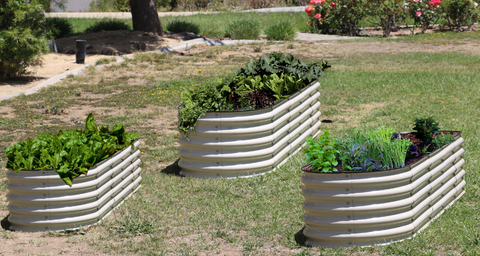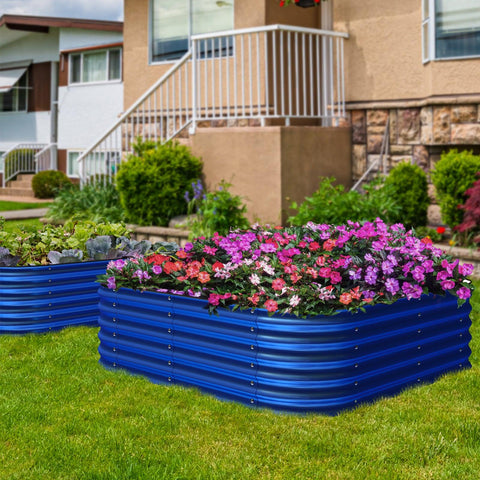How to Prep Your Garden Beds for Spring
It's a good idea to start preparing your garden bed as early as possible. By starting small, you can create a healthy environment for your vegetables to grow in during the hot summer months. And that way you can pin down the exact type of vegetables and types of plants you would like in your garden bed.
When we moved to our new home, we knew we wanted a big garden next spring. But we moved late, it was the Open Day of deer season, and we didn't pick out a field and prepare it before the snow started flying.
Preparing garden beds in the fall is the best way to go, but it's certainly not the only way. You can prepare a new garden bed in the spring with just a little more work.

How to prepare a garden bed
Bed selection
Ideally, you want a place that receives at least six hours of sunlight a day and is well drained. Of course, most of us don't have an ideal garden location, so we have to modify the soil, build raised beds, or simply be content with what we have when it comes to choosing the ideal location for our garden.
The other part of this step is to make sure that if you are digging the garden bed, there are no buried utility lines. We live in the county and only our electricity is marked, so we have to know where our Wells and septic tanks are.
You shouldn't have to dig deep enough to hit anything, but it's always worth making sure. So if you're not off the grid and aren't sure where your utility lines are running...... Mark them. It's free and only takes a day or two.
Remove all weeds, grass, and anything else from the plot
A lot of our garden beds are actually covered in a layer of asphalt. So, we're lucky because we don't have a lot of grass and weeds to get rid of. But, on the other hand, we have a ton of thick asphalt and rock that needs to be removed and put somewhere else.
You need to remove all grass, weeds, and any other vegetation from the plot before you can actually start working.
There are many ways to do this. You can throw the vinegar down and let it work its magic. This will take a day or two, and then you can remove the dead vegetation.
You can cover the entire area with black plastic and smother weeds and grass. This will take longer than vinegar, but it won't change the composition of your soil, and it will warm your soil if you work in the spring.
Alternatively, you can use a shovel and dig down 12 to 18 inches, then cut in chunks to remove grass and weeds. You can then take the blocks and turn them upside down into a pile, and they will compost into beautiful, rich compost that you can add back to your garden later.
It's perfectly okay to leave some behind (see the image below, which definitely has some green in it), but you want most of it to go away.
I don't suggest you go first. You're just asking for weeds. Removing all this grass will be hard work, but trust me, it will be worth it. If you have a lot of large rocks in your soil, you can also remove them at this time.
Wet the plot
If it hasn't rained recently, you'll need to make wetland blocks before you start tilling the soil.
You don't want the soil to be soggy and muddy. Not only would this cause a huge mess, but it would make the job more difficult because the soil would just clump together.
If you have completely dry soil, it will be difficult to access impossible to work with and may damage the soil.
So you really want the soil to be moderately moist before you start working. You are looking for soil that is easy to work with, and will break when working, but will not stick to the tool or look like mud.
If you've had heavy rain recently, you may want to hold off for a day or two.
Cultivated soil
This is the hard part. You can farm it, which is what we do, but you will only be working the soil to a depth of about eight inches, which is not ideal.
Ideally, you want to work to a depth of 12 or even 18 inches. We will eventually in the long run, but we use our spinner to do most of the work and till twice to get to the depth we want.
If you use a shovel to remove vegetation before tilling, you already have depth where you need it. You just tweak it a little bit and call it good.
You don't want to crush the dirt, just aerate it for better drainage. The number one predictor of well-drained soil is oxygenated soil, so clean the dirt a little to form pockets so that it can drain.

Add a thick layer of compost
On beautiful soil, you'll want to add a very thick layer of compost. You will want to make this layer fairly thick, I recommend about 4 inches.
You'll want to put this compost in your garden. This is the second time we have used the rotary machine. You can skip this step if you want, but we want to make sure it works well with the soil, so we farm it all together.
Make sure you add well-aged compost, especially if you plan to plant it after making your bed, rather than letting it winter. If you put manure or other hot organic matter on your soil, your plants will not thrive and may die completely.
Rake the soil
Once you've plowed it all up, you'll probably still have some chunky stuff and rocks. Especially if you put your garden plot where asphalt used to be laid, but I digress......
It will also be slightly uneven. Or maybe this is just when I try to use a spinner. You don't want your garden to have a lot of peaks and valleys, you want it to be fairly flat so that water doesn't stand up in certain areas.
Take a rake and rake through the newly tilled soil to look for any clumps and any large rocks and remove them.
I was gentle about it and did a lot with the back of a rake, just to push the soil and level things. The farming process yielded many rocks for us.
Bordering the garden plot
Placing borders around your plot with blocks, wood, or even cheap landscape edges will help keep weeds and grass out of your garden. It's not necessary, but it can be helpful.
The goal here is to prevent weeds from creeping back to the edges of the garden. So, dig it down a little bit. Alternatively, you can mulch around the border, but you may want something to keep the mulch in place. This is optional, of course, but it helps a lot, so I'm adding it.
Planted garden bed
Once you've got the soil working, added compost or organic matter, and raked everything out, it's time to plant!
As long as you use well-aged compost, you're ready to plant. Whether you start seedlings or pick them up from your local nursery, you can plant.
Covered garden bed
After you've planted everything, you'll need to add a 3-4 inch layer of mulch on top. I strongly recommend using old hay bales. Yes, you read that right. If possible, I cover my garden with hay instead of straw.
Old hay, stale, new hay. When you didn't get old hay last fall, the best way to get old hay is to find a farmer who has some old hay that has been out all winter.
You want old bundles that have been left out of the element, as this allows the seeds to germinate and the bundles to start breaking down. Hay makes a wonderful nutritional addition to your garden, while straw is almost useless in this sector.
However, you do not want to add freshly cut hay to your garden. You'll end up with all kinds of weeds/grass everywhere. So, if you can't get hay, use straw or wood shavings.
Another warning is to make sure that anything you use for mulch is not sprayed. It is important to know your farmers and that they know what is being done to their fields. Some farmers are surprised to find that the chemicals they spray kill vegetation when hay or straw is placed in the garden.

Water
Once you've got everything in place, it's time to water it. Watering a garden is an art. You want to water everything very deep. A bit like a good rain would do. The top mulch will help keep the moisture content where it needs to be.
This year, you will have a beautiful, productive garden with a good harvest from the garden bed you just prepared this spring. Next year? You'll have beautiful, nutrient-rich soil right from the start. You have this. Go to your garden!
